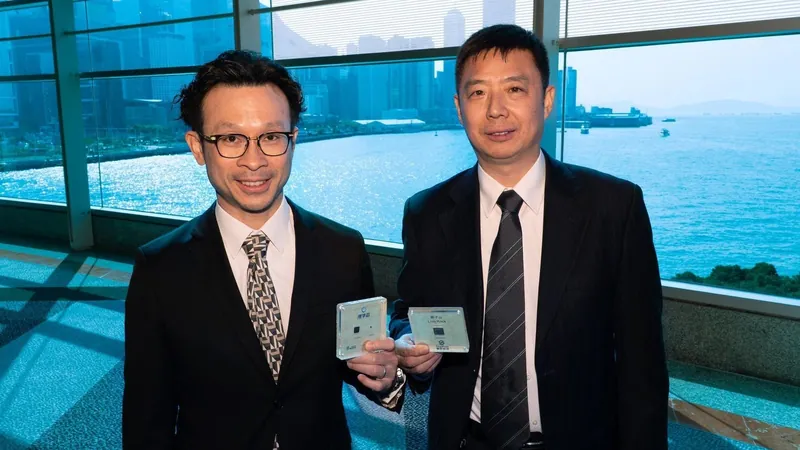
The Rise of Starfive: A Hong Kong Billionaire's Vision for Semiconductor Independence
2025-04-01
Author: Chun
Introduction
In a significant shift in the world of semiconductor design, a Hong Kong-backed startup named Starfive Technology is pioneering the development of computer chips that embrace an open-source architecture known as RISC-V. This strategic move comes as China intensifies efforts to detach its semiconductor industry from Western technologies, particularly in light of escalating tensions with the United States.
Starfive's Background and Mission
Starfive, founded in 2018 and backed by billionaire investor Peter Lee, has strategically focused on a clear path to chip independence. By utilizing the RISC-V architecture—an open-source alternative to industry standards like Intel’s x86 and Arm’s designs—the startup aims to navigate the complexities of the current geopolitical landscape. RISC-V's open-source nature allows designers across the globe, including China, to innovate without being bound to Western corporate controls.
Initial Products and Market Success
Starfive's initial foray into the semiconductor market was with a smart gas meter chip tailored for automatic data collection, a venture that aligns closely with Lee's other business interests as the head of Hong Kong & China Gas. Following a successful launch in late 2022, Starfive secured substantial orders, reportedly totaling four million chips for its smart gas meter solution.
Expansion into Data Centers
With its groundwork laid in the energy sector, Starfive is now targeting the rapidly expanding data center sector. The company is preparing to roll out a RISC-V-based chip for data center management, already forging a partnership with Xfusion Digital Technologies, a subsidiary of the technology powerhouse Huawei. This move highlights Starfive's ambition to carve a significant niche for itself in the semiconductor landscape.
Leadership and Future Goals
Starfive’s founder and CEO, Thomas Xu, a veteran in semiconductor design, asserts the competitiveness of Starfive's RISC-V offerings. "Currently, we are not aware of any other companies creating RISC-V-based chips similar to our data center management solution," Xu remarked, expressing confidence in their unique market positioning.
Navigating Geopolitical Tensions
As China is under increasing pressure from U.S. sanctions aimed at restricting access to advanced semiconductor technologies, Starfive’s collegiate approach and the underlying support for RISC-V represent vital steps toward achieving technological sovereignty. The momentum behind RISC-V is gaining governmental backing, with the Chinese authorities reportedly planning to promote these chips for nationwide use.
Peter Lee's Vision and Strategic Decisions
Lee’s vision for Starfive was shaped by foreseeing the escalating economic fragmentation between the U.S. and China. He played a crucial role in persuading SiFive, an American chip designer instrumental in creating RISC-V, to establish a division in China that would later evolve into Starfive. Lee’s prescience about the potential tech decoupling has positioned Starfive favorably, attracting investments from prominent entities including the Hong Kong Investment Corporation, Baidu, and state-supported funds.
Focus on Gradual Growth
Unlike other startups jumping on the lucrative AI bandwagon, Starfive is committed to a methodical approach, focusing on developing specific applications before expanding into more competitive areas such as AI. Managing Partner of Full Vision Capital, Alan Chan, emphasizes the startup's philosophy of gradual growth and avoiding the pitfalls of speculative investment trends.
Future Expansion Plans
In the coming years, Starfive aims to expand its offerings, particularly focusing on data center applications, with an ambition to support both traditional and AI-integrated infrastructure in Hong Kong and mainland China. Their discipline has led to declining some significant proposals, including a $100 million offer to develop an AI chip, in favor of refining their existing product focus.
Conclusion
As China continues to champion RISC-V amid an AI-driven market landscape, Starfive is strategically positioning itself to dominate in niche applications while maintaining a clear vision of its growth trajectory. This calculated approach underlines their commitment to building a robust semiconductor ecosystem, free from dependency on Western technology.






 Brasil (PT)
Brasil (PT)
 Canada (EN)
Canada (EN)
 Chile (ES)
Chile (ES)
 Česko (CS)
Česko (CS)
 대한민국 (KO)
대한민국 (KO)
 España (ES)
España (ES)
 France (FR)
France (FR)
 Hong Kong (EN)
Hong Kong (EN)
 Italia (IT)
Italia (IT)
 日本 (JA)
日本 (JA)
 Magyarország (HU)
Magyarország (HU)
 Norge (NO)
Norge (NO)
 Polska (PL)
Polska (PL)
 Schweiz (DE)
Schweiz (DE)
 Singapore (EN)
Singapore (EN)
 Sverige (SV)
Sverige (SV)
 Suomi (FI)
Suomi (FI)
 Türkiye (TR)
Türkiye (TR)
 الإمارات العربية المتحدة (AR)
الإمارات العربية المتحدة (AR)